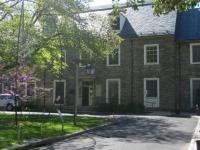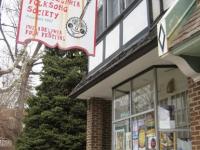Archival Adventures in Small Repositories
Archival Adventures in Small Repositories

Imagine taking an afternoon stroll through a meticulously sculpted garden, winding along pathways lined with flowers and shrubberies overlooking majestic view of the Schuylkill River. Detailed sculptures are scattered along the path, depicting cherubs and angels. You pass stelae and obelisks, and as you continue, you find yourself surrounded by elaborate mausoleums. Not only are the stone structures beautiful works of art, decorated with detailed carvings and Tiffany stained glass windows, but they also serve as the final resting place for the deceased.
This past winter and spring HCI-PSAR facilitated an internship program that paired emerging archivists in need of hands-on experience with small repositories in need of processing assistance and large repositories willing to train and supervise the intern. We matched intern Daniel DelViscio with the Old York Road Historical Society and Drexel University College of Medicine Archives & Special Collections. Daniel reflected on Isabel Smith Stein collection on Elizabeth Cisney Smith, the Kiwanis Club of Jenkintown records, and his other experiences in the blog below.
After nearly 3½ years working on the Small Repositories Project, the time has come for me to say good-bye. I'm more than a little sad to be leaving HCI-PSAR prematurely (Phase III will end April 2016), even though I'm delighted to be accepting a new position at the Friends Historical Library at Swarthmore College. It gives me some solace to reflect on my accomplishments as HCI-PSAR Senior Project Surveyor, so I hope you'll indulge me here.
In the past 3½ years, I personally have:
In the three and a half years I've worked on the HCI-PSAR project, I've met hundreds of individuals at area small repositories who are passionate about preserving the archival collections under their care. I've been impressed at how proactive many of you have been in seeking opportunities to learn professional standards, but I've also noticed that you each bring a unique perspective and innovative ideas to the tasks at hand.
Because Presidents' Day is this coming Monday, this week's blog post will highlight materials related to United States presidents that we have found in the collections of small repositories during the course of the HCI-PSAR project.
Hold onto your yarmulkes and brush up on your Hebrew! In this week's blog post, we'll delve deep into the archives of Mikveh Israel of Philadelphia, one of the oldest Jewish congregations in the United States. Its congregants have included many luminaries who were influential in religious and secular contexts, locally and often nationally. Of course, not all of Mikveh Israel's members are famous. Mikveh Israel's extensive archives also document the lives of ordinary Jews and the Jewish community in Philadelphia, covering more than 250 years.
Isaiah Williamson was born into a family of Quaker farmers in Fallsington, Pennsylvania (Bucks County) on February 4, 1803. Raised on the family farm alongside seven siblings, by 1818, Williamson had begun working as an apprentice in a store near his home. Over the course of the next seven years, he saved enough money to open and run his own dry goods store in Philadelphia.
Philadelphia's Central High School is the second oldest continuously public high school in the United States. Chartered in 1836, its first building, located at Juniper and Market streets, opened its doors in 1838. The school has changed buildings three times (1854, 1900, and 1939) since then and is currently located in its fourth building at the corner of Ogontz and Olney avenues. Since 1849, Central has been allowed to grant Bachelor of Arts degrees to its graduates who have met the degree requirements. Today, Central is the only high school in the country with this ability.
In 1956, Philadelphia area folk musicians George Britton and Mike Marmel, folk music enthusiast Joe Aronson, and other local folk artists and fans discussed the possibility of creating a group (open to performers and non-performers alike) centered around the performance and enjoyment of folk and traditional music. After further discussion, it was decided that this group would hold nine meetings each year with each meeting consisting of a small performance in an intimate setting.
Darby Library Company was founded in 1743, a subscription library open to any paying subscriber (although not gratis to the public). The original twenty-nine subscribers authorized the purchase of forty-five volumes at a cost of 11 Pounds, 10 Shillings, Sterling. The list of titles - a few of which are visible in the image at the top of this post - reveals the values and aspirations of the subscribers.
- ‹ previous
- 3 of 21
- next ›
Image Permissions
Unless otherwise noted, all images in this blog post are property of the organization profiled, not the Historical Society of Pennsylvania. To reproduce any image or obtain a higher quality version, please contact the organization directly.










